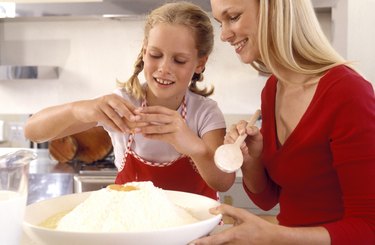
Eggs are a basic ingredient in cake recipes. Bakers create few if any cakes without eggs because the ingredient plays so many crucial roles in the baking process. The only exception to egg inclusion is when bakers prepare vegan cakes. Even then, an egg-like substitute is in the recipe in place of the authentic product. Eggs provide moisture and flavor and support the structure of the finished cake. Eggs are indispensable; contemporary cakes wouldn't be possible without them.
Adding Moisture
Video of the Day
Cake recipes include a multitude of dry ingredients, yet few wet ingredients. Though cream or buttermilk may also feature in a recipe, eggs are often the most abundant liquid ingredient. Cakes begin as batter which allows bakers to create cakes in various shapes and sizes because a liquid is more malleable than a solid. As a result of the cake's liquid beginnings, the final solid cake is lighter and softer than other baked treats that begin in a solid state, such as dense and heavy cookies.
Video of the Day
Binding the Ingredients
The water and proteins in eggs are what binds all of the dry ingredients. A mixture of dry ingredients doesn't bind into one solid without the addition of a liquid. Eggs are the preferred liquid ingredient because the abundant protein in eggs binds the mixture stronger than other liquid components such as milk or oil.
Holding the Shape
The protein in eggs is important to a cake holding its shape. One of the dry ingredients in every cake recipe is a leavening agent, which introduces air into the mixture as it bakes, creating the tiny pockets of space that make cakes light and soft. Baking powder is the most common cake leavener. As it releases air in the baking cake, the egg proteins coagulate and form a rigid structure around the leavener's tiny air pockets. The leavening agent expands a cake into a voluminous shape; egg is the component that holds the cake in its expanded position.
Color and Flavor
Egg yolks contribute two other key qualities to cakes. The rich hue of the yolk colors cake batters and is responsible for the yellowish tint in yellow cakes. Egg whites alone don't give a cake color. Angel food cake is an example of a cake with egg whites and no yolks. Only a darker component, such as food coloring or chocolate, overrides the yellow hue of egg yolks in cake batter. Yolks also contribute fat to the cake, contributing to the richness of its flavor. For example, a basic yellow cake tastes richer than angel food cake.